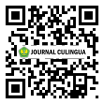BILINGUALISM IN CHILDREN’S LITERATURE ENTITLED 25 BEAUTIFUL FRIENDSHIP
DOI:
https://doi.org/10.37301/culingua.v1i1.1Keywords:
bilingualism, children literature, 25 beautiful friendshipAbstract
Indonesia is one of the countries that has implemented a bilingual education program through English lessons since entry level. Therefore, this study aims to describe the effect of bilingual education on children’s language used. The object of research is a novel entitled 25 Beautiful Friendship by Annisa Zhahrotushama Balqis. Data description is managed by showing facts related to the influence of bilingualism (foreign language) on the language used by the author in her novel, such as giving names of titles, characters, places, food items, events and others. Based on the findings and results of the analysis above, it can be concluded that the massive teaching of foreign languages such as English into basic-level education has a significant impact on the way children convey their feelings and experiences in verbal communication.
References
Bhatia, T. K., & Ritchie, W. C. (Eds.). (2014). The Handbook of Bilingualism and Multilingualism (2nd ed.). Chichester, England: Wiley-Blackwell.
Butzow, J. W., & Butzow, C. M. (2000). Science through Children’s Literature: An Integrated Approach (2nd ed.). Englewood, CO: Libraries Unlimited.
Creswell, J. W., & Creswell, J. D. (2018). Research design: Qualitative, Quantitative, and Mixed Methods Approaches. Thousand Oaks, CA: SAGE Publications.
Cummins, J. (1979). Linguistic Interdependence and The Educational Development of Bilingual Children. Review of Educational Research, 49(2), 222–251.
David, W. (1997). Extending literacy: Children Reading and Writing Non-Fiction. Taylor & Francis Group.
Dawis, A. (2009). The Chinese of Indonesia and their search for identity: The relationship between collective memory and the media. Cambria Press.
Garcia, O., & Wei, L. (2013). Translanguaging: Language, Bilingualism and Education. London: Palgrave Pivot.
Han, W. J. (2010). Bilingualism and Socioemotional Well-Being. Children and Youth Services Review, 32(5), 720–731.
Hayati, Y. (2016). Representasi Gender dalam Sastra Anak di Indonesia. Padang: UNP Press.
Hong, Y. Y., Morris, M. W., Chiu, C. Y., & Benet-Martínez, V. (2000). Multicultural Minds. A Dynamic Constructivist Approach to Culture and Cognition. The American Psychologist, 55(7), 709–720.
Kaushanskaya, M., & Marian, V. (2009). Bilingualism Reduces Native-Language Interference During Novel-Word Learning. Journal of Experimental Psychology. Learning, Memory, and Cognition, 35(3), 829–835.
Lesnik-Oberstein, K. (Ed.). (2004). Children’s Literature: New Approaches. London, England: Palgrave Macmillan UK.
Letsholo, R. (2009). Language Maintenance or Shift? Attitudes of Bakalanga Youth towards Their Mother Tongue. International Journal of Bilingual Education and Bilingualism, 12(5), 581–595.
McDowell, M. (1973). Fiction for Children and Adults: Some Essential Differences. Childrens in Education, 4(1), 50–56.
McGillis, R. (1996). The Nimble Reader: Literary Theory. Farmington Hills, MI: Twayne.
Mukhtar, A. S. (2018). Bilingualisme dan Diglosia. Retrieved September 13, 2020, from Kemdikbud.go.id website: https://kantorbahasamaluku.kemdikbud.go.id/2018/07/bilingualisme-dan-diglosia/
Mukminin, A., Haryanto, E., Sutarno, S., Rahma Sari, S., Marzulina, L., Hadiyanto, H., & Habibi, A. (2018). Bilingual Education Policy and Indonesian Students’ Learning Strategies. ?lkö?retim Online. doi:10.17051/ilkonline.2018.466330
Pramudita, W., & Anugraheni, I. (2017). Studi Penguasaan Matematika dan Bahasa Inggris Mahasiswa Program Studi Pendidikan Guru Sekolah Dasar (PGSD). Scholaria?: Jurnal Pendidikan Dan Kebudayaan, 7(1), 70.
Rahayu, D. (2016). Bilingualism of two Indonesian siblings living in Australia. Studies in English Language and Education, 3(2), 112.
Shavit, Z. (2010). Poetics of Children’s Literature. Athens, GA: University of Georgia Press.
Shin, S. J. (2017). Bilingualism in Schools and Society: Language, Identity, and Policy (2nd ed.). London, England: Routledge.
Silverman, P. D. (2015). Interpreting Qualitative Data (5th ed.). London, England: SAGE Publications.
Tucker, N. (1972). How Children Respond to Fiction. Children s Literature in Education, 3(3), 48–56.
Wijaya, I. K. (2015). Pembelajaran Bahasa Inggris di Sekolah Dasar. Bahtera Jurnal Pendidikan Bahasa Dan Sastra, 14(2), 120.
Ya?mur, K., & van de Vijver, F. J. R. (2012). Acculturation and Language Orientations of Turkish Immigrants in Australia, France, Germany, and the Netherlands. Journal of Cross-Cultural Psychology, 43(7), 1110–1130.
Downloads
Published
Issue
Section
License
Copyright (c) 2020 Muhammad Adek, Lilia Zahra Asifa

This work is licensed under a Creative Commons Attribution 4.0 International License.









